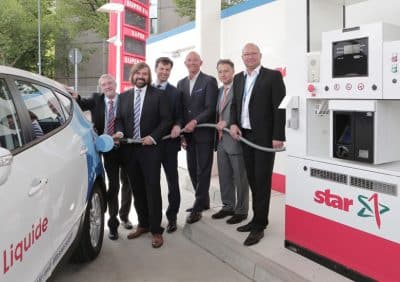The German H2 infrastructure is growing steadily. Early this year, Linde expanded its offering around Munich by turning the Linde Hydrogen Center in Unterschleissheim into a public refueling station. What had previously been the industrial gas supplier’s hydrogen R&D facility has been used since Jan. 12 to fill up fuel cell cars such as the ones owned by Linde’s subsidiary BeeZero.
As part of the Clean Energy Partnership, Air Liquide has so far opened one filling station in Kamen, Limburg an der Lahn and Mülheim in 2017. All three received over EUR 800,000 each by the federal transportation ministry. Their daily capacity of 200 kilograms is enough to refuel up to 40 cars.
The first one was inaugurated on Jan. 18, 2017, on Schattweg at the interchange near Kamen in North Rhine-Westphalia and went online four weeks later. The system in the state of Hesse, on Brüsseler Strasse near the A3 freeway, was completed on Jan. 26 and opened in mid-March. The one in Mülheim, where a joint project with Orlen Deutschland saw it integrated with a Star gas station, was inaugurated on May 23. Antoine Mazas, managing director of Air Liquide Advanced Technologies, explained: “Hydrogen will be key for progressing toward a low-carbon society.”
A few days earlier – on May 19 – H2 Mobility brought one of its first units online, bestowing the Total gas station in Rostock with the honor of being the first public multi-energy supply location in the state of Mecklenburg-Vorpommern. It offers both hydrogen and electricity besides fossil fuels. On June 14, Norbert Barthle, parliamentary state secretary at the BMVI, inaugurated the Shell station on Hanauer Landstrasse in Frankfurt am Main. On the same day, there was also the opening of the location on Borsigstrasse in Wiesbaden-Nordenstadt, Hesse.
Bremen seems to be next in line: The gas pressure vessel at the Shell station on Osterholzer Heerstrasse in the city state had already been set up to prepare for the unveiling of the GLC F-Cell – a car planned to be manufactured by Mercedes in Bremen’s Sebaldsbrück suburb – at the International Motor Show in September. A Daimler spokesperson, however, told the local Weser Kurier newspaper: “It certainly isn’t a mass-market product yet. But it’s a good option for the future.”
Other refueling stations will reportedly come online in Pentling, Nuremberg, Bad Rappenau, Wolfsburg, Düsseldorf and Cologne-Bonn. But some states, namely Brandenburg, Saxony, Saxony-Anhalt, Thuringia, Schleswig-Holstein and Saarland, still have much catching up to do (see also H2 Refueling, the German Way).
In Austria, the fourth OMV station came online in late March. Partly funded with support from the European COHRS or Connecting Hydrogen Refueling Stations program and located in Graz-Liebenau, directly at the A2 interstate, it is situated at one of the most crucial traffic corridors across Europe. Wilfried Gepp, manager at OMV, said: “It’s the first time that drivers of hydrogen cars have been able to travel all around Austria – from north to south, west to east and vice versa.” And in the middle of this year, Wiener Neudorf was said to get its own refueling station.



























0 Comments